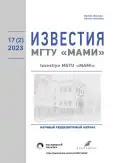To the question of the description of the internal combustion engine in the mathematical model of the lifting system of the hovercraft (on the example of the ZMZ-51432.10 CRS engine)
- Authors: Lepeshkin A.V.1, Nguyen V.2
-
Affiliations:
- Moscow Polytechnic University
- Bauman Moscow State Technical University
- Issue: Vol 17, No 2 (2023)
- Pages: 107-114
- Section: Heat engines
- URL: https://ogarev-online.ru/2074-0530/article/view/253967
- DOI: https://doi.org/10.17816/2074-0530-472097
- ID: 253967
Cite item
Full Text
Abstract
Introduction. It is known that about one third of the total capacity of the power plant of the hovercraft (SVP) is spent on the creation of an air cushion that ensures the rise of the main hull of the vessel. At the same time, in SVP, the source of mechanical energy, as a rule, is a diesel internal combustion engine (ICE). This article discusses one of the issues related to the creation of a mathematical model of the lifting system of the SVP, using: ICE, hydraulic transmission, axial fans and an air cushion nozzle scheme. Since in the vast majority of cases, the internal combustion engine performs its work in partial load modes, it becomes necessary to effectively control the power of the internal combustion engine in order to achieve its high efficiency in partial load modes.
AIMS. The purpose of this study is to develop a mathematical description of the operation of the internal combustion engine both in external and partial modes of operation, for use in a mathematical model of the operation of the lifting system of the SVP.
Methods. In this study, a ZMZ-51432.10 CRS diesel engine is used for the lifting system of the hovercraft.
Results. Using the data obtained using the DIESEL-RK program for this ICE, in the Microsoft Excel environment, the corresponding trend lines were obtained for them by approximating the points that identify the partial characteristics of the engine with fourth-order polynomials, as well as the dependence of the coefficients of these polynomials on the control parameter of the ICE operation mode .
Conclusion. The developed mathematical description of engine operation can be integrated with various load models when simulating real systems using internal combustion engines as energy sources. This means that it can also be used in mathematical modeling of the SVP lifting system in the MATLAB Simulink package.
The approach proposed in this article makes it possible to build mathematical models of various systems using internal combustion engines, simplifying the study and saving computational time. Also, the results obtained can be of reference value.
Full Text
##article.viewOnOriginalSite##About the authors
Alexander V. Lepeshkin
Moscow Polytechnic University
Email: lep@mami.ru
ORCID iD: 0000-0002-5590-7422
SPIN-code: 4412-6948
Professor, Cand. Sci. (Tech.), Professor of the Industrial Heat Power Engineering Department
Russian Federation, 38, Bolshaya Semenovskaya st., MoscowVan Hoa Nguyen
Bauman Moscow State Technical University
Author for correspondence.
Email: thoigian226@gmail.com
ORCID iD: 0009-0000-0843-2738
SPIN-code: 7676-2873
Postgraduate of the Hydromechanics, Hydromachines and Hydro-Pneumoautomatics Department
Russian Federation, 5, 2nd Baumanskaya street, 105005 MoscowReferences
- Knyazev SI, Lomovskikh AE, Guliev ERO. Development of a stand to study the influence of the air coefficient on the energy and economic performance of internal combustion engines. Nauka i obrazovanie na sovremennom etape razvitiya: opyt, problemy i puti ikh resheniya. 2019. С. 84–87. (in Russ.)
- Kukharenok GM. Theory of working processes of internal combustion engines: a methodological guide for students of correspondence courses in the specialty "Internal combustion engines". Minsk: BNTU; 2011. (in Russ.)
- Diesel engine model ZMZ-51432 CRS for UAZ vehicles of ecological class 4. Design, operation, maintenance and repair [internet] (in Russ.) Accessed: 20.05.2023. Available from: http://www.uazprofi.ru/files/userfiles/Katalogi/zmz_51432_patriotE4_2013.pdf
- Kuleshov AS, Kozlov AV, Fadeev YuM, et al. Diesel-RK program: modeling and optimization of internal combustion engines. In: Collection of proceedings of the international scientific and technical conference "Engine-2010", dedicated to 180 anniversary of MSTU im. N.E. Bauman / Edited by NA Ivashchenko, VA Wagner, LV Grekhov. Moscow: MGTU im NE Baumana; 2010. С. 287–292. (in Russ.) Accessed: 20.05.2023. Available from: http://piston-engines.ru/images/konferencia/2010/articles/287-292.pdf
- Kuleshov A, Grekhov L. Multidimensional Optimization of DI Diesel Engine Process Using Multi-Zone Fuel Spray Combustion Model and Detailed Chemistry NOx Formation Model. SAE 2013 World Congress & Exhibition. Allegheny County: SAE International; 2013. doi: 10.4271/2013-01-0882
- Kuleshov A, Mahkamov K. Multi-zone diesel fuel spray combustion model for the simulation of a diesel engine running on biofuel. Proceedings of the Institution of Mechanical Engineers. Part A. Journal of Power and Energy. 2008;222(3):309-321. doi: 10.1243/09576509JPE530
- Software complex DIESEL-RK [internet] Accessed: 20.05.2023. Available from: https://diesel-rk.com
- Patent USSR. SU 1673909 A1 / 30.08.1991. Khokhlov FF, Shtyka MG, Shtyka AG. Sposob regulirovaniya moshchnosti dizelya. (in Russ.) Accessed: 20.05.2023. Available from: https://patents.su/4-1673909-sposob-regulirovaniya-moshhnosti-dizelya.html
- Пухов А.А., Гринкруг М.С. Способы регулирования мощностей двигателей внутреннего сгорания, работающих по циклу дизеля // Производственные технологии будущего: от создания к внедрению. 2022. С. 293–296. (in Russ.)
- Lepeshkin AV, Kurmaev RKh, Katanaev NK. Identification of the operation of the engine of a self-propelled machine for use in the mathematical model of its movement (on the example of the DT466 engine). Izvestiya MGTU «MAMI». 2007;1(2):68–73. (in Russ.) doi: 10.17816/2074-0530-69558.
Supplementary files













